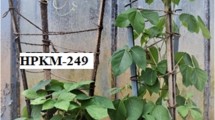Abstract
The genome locations of the wound-response genes that were expressedduring the post-harvest physiological deterioration (PPD) of cassava, suchas phenylalanine ammonia lyase, β-1.3 glucanase, hydroxyprolinerich glycoprotein, catalase, 1-aminocyclopropane 1-carboxylate, cysteineprotease inhibitor, aspartic protease, a partial cDNA for serine/threonineprotein kinase and peroxidase, have been identified on the frameworkmolecular genetic map of cassava. Also, molecular markers linked toputative quantitative trait loci (QTLs) influencing PPD of cassava weremapped using an F1mapping population derived from elite parentallines (TMS 30572 × cm 2177-2). A molecular linkage map previouslyconstructed based on the segregation of 240 RFLP, 100 RAPD, 85microsatellite and five isoenzyme markers on 144 F1 individuals wasused for the QTL mapping.A set of 10 molecular markers with a significant association with putativeQTLs for PPD were identified based on probability values < 0.005in order to minimize the detection of false positives. Based on single-markerregression, eight putative QTLs located on the linkage groups G, P, L, U,and X of the female-derived framework map were found to explain between 5–12% of the phenotypic variance of the PPD. In the male-derived frameworkmap, two putative QTLs on linkage groups C and L explained 13% and11% of this variance, respectively. This study thus identified the majorgenome regions of cassava related to physiological post-harvestdeterioration, thereby providing tools for the identification of gene(s)controlling this trait.
Similar content being viewed by others
References
Beeching, J.R., A.D. Dodge, K.G. Moore, H.M. Phillips & J.E. Wenham, 1994. Physiological deterioration in cassava: possibilities for control. Trop Sci 34: 335–343.
Beeching, J.R., Y. Han, R. Gó mez-Vásquez, R.C. Day & R.M. Cooper, 1998. Wound and defense responses in cassava as related to post-harvest physiological deterioration. Recent Adv in Phytochem 32: 231–248.
Beeching, J.R., Y. Han & R.M. Cooper, 1997. Physiological deterioration: towards a molecular understanding. Afr J Root Tuber Crops: 99–105.
Dellaporta, S.L., J. Wood & J.R. Hicks, 1983. A plant DNA minipreparation: version II. Plant Mol Biol Rep 1: 19–21.
Fregene, M., F. Angel, R. Gó mez, F. Rodríguez, W. Roca, J. Tohme & M. Bonierbale, 1997. A molecular genetic map of cassava (Manihot esculenta Crantz). Theor Appl Genet 95(3): 431–441.
Han, Y., H. Li, R.M. Cooper & J.R. Beeching, 2000. Isolation of post-harvest physiological deterioration related cDNA clones from cassava. In: L.J.C.B. Carvalho, A.M. Thro & E.D. Vilarinhos (Eds.), Cassava Biotechnology, pp. 526–536. 4th Int Sci Meet Cassava Biotech Network, Salvador, Brazil. Brasilia, Embrapa.
Han, Y., R. Gó mez-Vásquez, K. Reilly, H. Li, J. Tohme, R.M. Cooper & J.R Beeching, 2001. Hydroxyproline-rich glycoprotein expressed during stress responses in cassava. Euphytica 120: 59–70.
Iglesias, C., J. Bedoya, N. Morante & F. Calle, 1996. Genetic diversity for physiological deterioration in cassava roots. In: G.T. Kurup et al. (Eds.), Tropical Tuber Crops: Problems, prospects and future strategies, pp. 115–126. Lebanon, NH, USA.
Lander, E.S., P. Green, J. Abrahamxon, A. Bariow, M.J. Daly & E.S. Lincoin, 1989. Mapping Mendelian factors underlying quantitative traits using RFLP linkage maps of experimental and natural populations. Genomics 1: 174–181.
McIntosh, M.C., 1983. Analysis of combined experiments. Agron J 75: 153–155.
Mba, R.E.C., P. Stephenson, K. Edwards, S. Melzer, J. Nkumbira, U. Gullberg, K. Apel, M. Gale, J. Tohme & M. Fregene, 2001. Simple sequence repeat (SSR) markers survey of the cassava (Manihot esculenta Crantz) genome: towards an SSR-based molecular genetic map of cassava. Theor Appl Genet 102: 21–31.
Nelson, J.C., 2000. Qgene: a computer package for the marker-based analysis of population, user manual. http://www.qgene.com. 35 p.
Reilly, K., Y. Han, J. Tohme & J.R Beeching 2000. Oxidative stress related genes in cassava post-harvest physiological deterioration. In: L.J.C.B. Carvalho, A.M. Thro & E.D. Vilarinhos (Eds.), Cassava Biotechnology, pp. 560–571. 4th Int Sci Meet Cassava Biotech Network: Salvador, Brazil. Brasilia, Embrapa.
Reilly, K., Y. Han, J. Tohme & J.R. Beeching, 2001. Isolation and characterization of a cassava catalase expressed during postharvest physiliogical deterioration. Biochimica Et Biophysica Acta 1518: 317–323.
Rickard, J.E., 1985. Physiological deterioration of cassava roots. J Sci Food Agric 36: 167–176.
SAS Institute Inc., SAS/STAT, version 6.12, Cary, NC, USA.
Wheatley, C., 1982. Studies on cassava (Manihot esculenta Crantz) root post-harvest deterioration. Ph.D. thesis. University of London, UK. 246 p.
Author information
Authors and Affiliations
Rights and permissions
About this article
Cite this article
Fernando Cortés, D., Reilly, K., Okogbenin, E. et al. Mapping wound-response genes involved in post-harvest physiological deterioration (PPD) of cassava (Manihot esculenta Crantz). Euphytica 128, 47–53 (2002). https://doi.org/10.1023/A:1020695719706
Issue Date:
DOI: https://doi.org/10.1023/A:1020695719706




